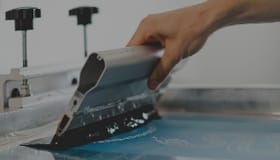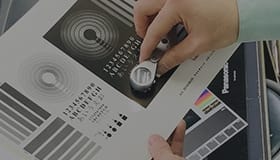Past events
Exhibition Report of 1st Highly-functional PAINT & COATINGS EXPO
Event outline

We introduced inks that can realize reduction of Substance of Concern and improvement of productivity by substituting screen ink for painting and metal plating at "1st Highly-functional PAINT & COATINGS EXPO". In addition, we also exhibited inks for sensor which are printed on a light receiving port, conceal a sensor and enable to improve sensor accuracy.
- Period
- Dec. 05 - 07, 2018
- Venue
- Makuhari Messe, Japan
- Official HP
- https://www.coating-japan.jp/en-gb.html
List of Exhibits
- 1. Introduction of Film Insert Molding (FIM/IMD) as a substitute for painting
- 2. Introduction of ink for sensor that assists self-driving and AI
- 3. Introduction of both reduction of Substance of Concern and cost reduction by a substitute for metal plating
- 4. Introduction of High Definition Ink (High Quality and High Definition Screen Printing Ink)
- 5. Introduction of clear inks that have excellent scratch resistance such as SELF-RESTORING CLEAR keeping freshness of products.
- 6. Introduction of non-conductive function realizes both designability and quality of electronic devices
1. Introduction of Film Insert Molding (FIM/IMD) as a substitute for painting
1. What is Film Insert Molding ?
Film Insert Molding is also called In-Mold Decoration (IMD). It is a method that decorates a molded article by inserting a screen printed film into a mold and molding integrally.
Processes of Film Insert Molding to realize a substitute for painting
(1) Printing on decorative film (2) Forming (3) Trimming (4) Injection

Example where piano black (jet black) and mirror ink (substitution for metal plating) are printed with a roll coater

2. Excellent design reproducibility of Film Insert Molding
Film Insert Molding enables to design freely using multicolor, fine lines and gradation that are difficult in painting because decoration is done by print. Utilizing our High Definition Ink for molding, you can create ultra-high quality designs by fine lines and gradation dots of 100µm level that you had never before.
Example of a design including color separation and fine lines of 100µm level that are impossible in painting (use High Definition Ink for molding)

Example of gradations by 100µm level dots which are impossible in painting (use High Definition Ink for molding)

3. Comparison between Film Insert Molding and painting
As mentioned above, Film Insert Molding enables to design freely by multicolor, fine lines and gradations that are difficult in painting. It has excellent resistance and productivity (reduction of the number of parts and lots for small amount) as well as designability.
| Items | Film Insert Molding | Painting |
|---|---|---|
| Designability | High quality and free design is possible by precise alignment and multicolor, fine lines and gradation. (Utilizing our High Definition Ink enables also ultra-high design of 100µm) | Basically solid color only. Design with fine lines and gradation is impossible |
| Finish | Back surface printing enables transparency of film and deeper color by multilayer printing. High quality decoration in large area is possible without sagging that occurs in painting. | Multilayer painting enables unique and deepen colors. Countermeasure for sagging is a challenge. |
| Types of resistance | Excellent scratch resistance etc. because of back surface printing. | There is a challenge in scratch resistance because painted surface is exposed. |
| Workability | High quality decoration is possible by space saving and simple processes. | Quality measure such as sagging protection is difficult due to many processes and complex processes. Special painting booth and ventilation equipment etc. are also required. |
| Environmental compatibility | Compared with painting, it is possible to reduce VOC generation. (We also prepare inks that do not contain Substance of Concern such as halogen etc.) | A lot of VOC occurs in painting process. |
| Cost | Both mass production, and small lot production of many types are possible. Printing efficiency by roll coasters can improve productivity further. Drastic rationalization of manufacturing is promising with a design that distinguishes each part by decorating multiple parts integrally. | Productivity improvement is restricted due to many processes and complex processes. Equipment investment such as painting booth and equipment for environmental measures is also necessary. |
2. Introduction of ink for sensor that assists self-driving and AI
1. Support concealing sensor and accuracy improvement by printing on light receiving port of sensor
Ink for sensor (infrared ray transmittable ink (IR transmittable ink)) has a function that a sensor transmits wavelengths to be detected and blocks other wavelengths (visible light and UV light, etc.). It is printed on the light receiving port of the sensor of communication devices such as smartphone etc. and contributes to concealing sensors and preventing malfunctions due to entry of unintended light.
Example of application:
Sensor for smartphone, Sensor for self-driving, Sensor for automated factory and equipment, Sensor for security purposes (entrance management, personal authentication and others)
Mechanism of ink for sensor

2. Improvement of both designability and accuracy of sensing function
Free decoration of ink for sensor not only conceals a sensor receiving port, but also can be used to add designability. Also, by adding a function such as scratch resistance to ink for sensor, it further contributes to improvement of sensor accuracy.
Example where the hand is properly recognized even the color sample of ink for sensor covers the sensor.

Example where both transmission of infrared ray and rich pearl color are realized (by color sample used above)

3. Application to concealing print by transmission of visible light
Ink for sensor is possible to selectively transmit wavelengths in a visible light region as well as IR (infrared ray) region. By applying this function, it is possible to have car navigation display which is usually integrated with other parts and displayed only when necessary.
Realize beautiful black of gloss/matte when backlight is off.

Express concealed patterns when backlight is illuminated.

3. Introduction of both reduction of Substance of Concern and cost reduction by a substitute for metal plating
1. Mirror ink (mirror effect ink) which realizes high gloss
By substituting screen ink for metal plating, both reduction of Substance of Concern and cost reduction are realized at once. Mirror inks are used for home appliances, mobile phones and automobile interiors etc. Also, by utilizing light reflection power of mirror surface, it can be applied to components of illumination apparatus, optical devices and electronic devices etc.
Example of the mirror ink where the pink molded article reflects on the mirror surface like a mirror

Example of adding vivid colors to mirror inks in combination with transparent inks

xample of combinations of mirror inks and molding (adding pearl silver, red and yellow, and others)

2. Comparison with mirror inks and metal plating
We introduce excellent functions of mirror inks compared with metal plating.
| Item | Mirror ink | Metal plating |
|---|---|---|
| Designability | Free designs are possible to combine with multiple colors, fine lines and gradation, and one point logo of metallic etc. | Impossible to combine with other designs because basically metal plating is done entirely. |
| Metallic gloss | Metallic gloss similar to metal plating is possible on film and glass. Mirror effect equivalent to mirror is possible especially on glass. | Gloss like a polished metal can be realized. |
| Various resistances | Excellent resistance such as scratch resistance because printed surface is back side. | Countermeasures for improvement of resistance such as corrosion are required because metal plating surface is exposed. |
| Environment-friendly | Not containing Substance of Concern such as heavy metal, halogen, etc. | Materials containing heavy metals which are hazardous substances are used in plating process. |
| Cost | Respond to both mass production and small lot production of many types because of few processes and simplicity. Substitute for metal plating can drastically reduce costs, as cost for environmental measures such as disposal of waste liquid, etc. are not necessary. | Many processes cause complication. Large amount of expenses are required for environmental measures such as disposal of waste liquid containing hazardous substances. |
4. Introduction of High Definition Ink (High Quality and High Definition Screen Printing Ink)
1. Fine lines and dots of 100 µm level can realize ultra-high quality design
High Definition Ink achieves fine lines with 100µm lines and spaces, gradation with 100µm dot diameter, solid with rich and even, and those are difficult with conventional screen printing.
Fine printing enables ultra-high quality design

Example of reproducing the design that is drawn circles with fine lines of 100 µm width without bleeding.

2. Alternative method by combination with 100 µm fine lines and functionality
Adding functionality to High Definition Ink that has high quality and fine printing function, screen printing by inexpensive facilities and few processes enables to have both fineness and functionality. For example, replacing the method requiring etching process with resist ink, it is possible to reduce costs drastically.
High quality printing of L/S 100µm that can be applied to functionality and decoration

Example of the high quality print of L/S 100µm (dot diameter 250µm) that can be applied to various applications (example of the printed material on the glass).

5. Introduction of clear inks that have excellent scratch resistance such as SELF-RESTORING CLEAR keeping freshness of products.
1. SELF-RESTORING CLEAR repairs itself from scratches due to rubbing
SELF-RESTORING CLEAR is a clear ink that keeps brand-newish state with self-restoring function of printed ink layer by obscuring scratches and abrasions of surface that occur during use. A printed ink layer with high flexibility can be applied as a clear for anti-slip.
Example of application:
Automobile interior, Home Appliance, Smartphone
Example of keeping a beautiful condition owing to self-restoring function even if it is rubbed many times with a wire brush.

2. Clear ink with scratch resistance achieves high scratch resistance by controlling structure of printed ink layer
A clear with scratch resistance is a clear ink that realizes high scratch resistance by balancing flexibility and hardness. Applying this high scratch resistance, it is possible to cut lamination process for scratch prevention during mass production. Because this clear provides 0.5 gross value of ultra-matte, it is ideal for automobile meters etc.
Example of application:
Automobile meter, Home Appliance, Smartphone
Excellent structure of printed ink layer with the balance of flexibility and hardness of printed ink layer.

Example of prevention clear with scratch resistance utilized for automobile meters.

6. Introduction of non-conductive function realizes both designability and quality of electronic devices
1. Realization of both non-conductive and metallic design
Metallic design was refrained from using and worried about failure of electronic devices due to conduction of printed ink layer since it is used conductive metallic powders. But, metallic designs for electronic devices are possible by using this non-conductive metallic ink (electrical resistance value of 10,000 times or more((109Ω or more) than ordinal metallic inks).
Example of application:
Home appliance, Mobile phone, Automobile, Electronic device
Example of non-conductive metallic inks that realize various expression due to variety of particle sizes.

Example of adding colors to metallic inks (not exhibited this time).

- Related technical information
-
- High Definition Ink System for Molding
- Introduction of new decoration of PP resin products.
- Technology lecture for FIM/IMD 1st session: Explanation of the merit and 3 process.
- Ink for sensor
- Introduction of IRX-HF ink
- Introduction of GLS-HF ink(2)
- Introduction of IR transmittable ink (IR Transmitting Ink) and concealed printing
- MIR-51000 Mirror Silver
- Mirror Ink (Mirror effect ink), substituting metal plating
- Introduction of MIX-HF(1)
- Introduction of High-Definition Ink (high-quality, high-definition screen ink)
- Introduction of 7 benefits
- Introduction of High Quality and High Definition Screen Printing Ink
- Introduction of FLG-HF G05
- Introduction of non-conductive Metallic ink
- Introduction of GLS-HF ink(4)
- Introduction of Non-Conductive Black ink
- Introduction of functional Black ink
Please feel free to contact us about the inks, methods, and trial products we have introduced.

